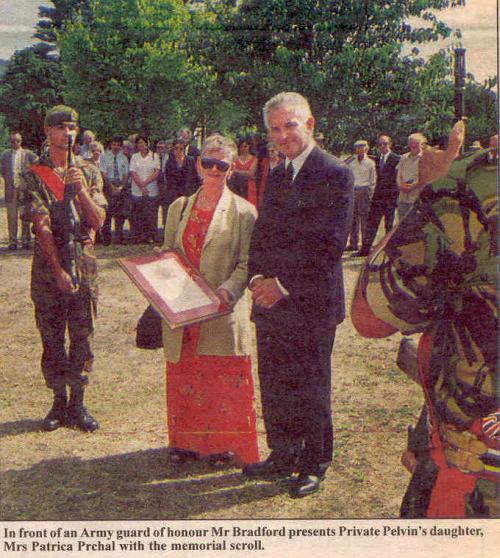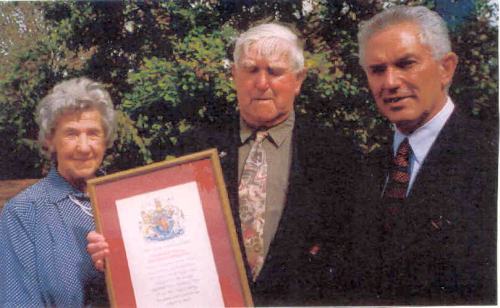|
Wattie was born 15/10/1908 at Waimate, the 2nd child
born to Arthur and Roseanna Pelvin and was baptised at
the Waihao Anglican Parish Church on the 12th November. At 5
years of age he contracted tuberculosis and was hospitalised. His
condition was serious and resulted in a lung having to be
collapsed, a rare operation at that time. Wattie made a full
recovery and commenced his schooling as a new entrant at
the Redcliff School on 6/3/1914, attending for about 6
years and for 6 monthsattended the Tawai
school travelling with his brothers and sisters in a horse and
gig.
In 1920 the family moved to
Timaru where Wattie attended the Waimataitai school and had two
years at Timaru Boys High School. He was a keen sportsman,
particularly a long distance swimmer, and his holidays were spent
swimming across Caroline Bay and back. He left school in 1925 and
became an electrician's apprentice. Unfortunately his employer
emigrated to South Africa three years later which meant Wattie could
not finish his training.
In 1929 Wattie's parents
returned to farming. They purchased 500 acres at Totara Valley
and here Wattie worked as a teamster on his father's farm for seven
years. An excellent pianist, it was during this period as a
ploughman he formed a band called the "Footwarmers" with two friends
- Wattie on the piano, Eugene O'Connell on banjo and Norman Fenwick
on violin and played at dances all over the district. The
1930's were incredibly social years - children and babies came
with their parents to the local dances.
Wattie moved to Wellington
in 1936 to work as a casual labourer - "seagulling" on the
wharf and here, on the 27th March 1938 he married Ivy Josephine
Willoughby, whom he had known at Geraldine. Their daughter
Patricia Anne was born a year later.
Wattie's volunteered for
service in the Army in 1941 after war broke out . The childhood lung
operation made him ineligble for
overseas service so Private Walter Pelvin, Army
Registration No. 496685 was assigned to serve within New
Zealand at the POW camp at Featherston - first as a
carpenter to assist in it's construction and afterwards, he was
asked to stay on as a guard. He was a popular camp member with
his skills as a musician, and played piano whenever the
opportunity arose.
The fateful
morning, February 25, 1943, Wattie was rostered for guard duty
in No 2 Compound. No details of how his
death occured were given to his mother - she stated to a son that
Wattie in a letter from the camp, told her the
Japanese arrived in such poor condition, he did not think they would
prove too much trouble. It was only after the war family learnt how
he had died three days later.
A popular man at the
Featherston camp, his death left his friends in shock.
Officers and men of the camp lined the route to Featherston when the
funeral cortege of Private Pelvin left the camp and a memorial
service was held there on the Sunday evening
following .
Walter Pelvin's burial
service was led at St Mary's Church, Geraldine on March 2, 1943 with
full military honours. He was interred in Geraldine
Cemetery, the only New Zealand soldier killed "On active
service" at home during WW2.
Three kilometres north of
Featherston on the morning of 28 February 1998, 55 years after the
tragedy. Defence Minister Max Badford presented the family of
Private Walter Pelvin with the New Zealand Memorial Scroll, awarded
to next of kin to servicemen who died in World War 2 to his daughter
Patricia Prchal who had been only 3 at the time. A plaque erected to
his memory is set in a concrete plinth opposite the ruins of
the former camp.

Speech Notes: Hon. Max
Bradford, Minister of Defence.
Saturday 28 Feb 1998 11.30
am
Memorial Scroll Presentation to
the family of Walter Pelvin, New Zealand guard
killed during the Japanese riot at Featherston POW Camp 1943
Your Worship, councillors, members of Private
Pelvin's family and the Featherston community.
I am honoured to be asked to make a
presentation to the family of Private Pelvin.
Although there was no fighting in New Zealand
during World War II, there more than 1,300 war graves spread across
the country. of men and women who died during training, through
accidents, or in hospitals from injuries they received in fighting
and memorials like the one here to Private Walter Pelvin, who 55
years ago today, died here at the age of 34 in the service of his
country.
The Prime Minister of the time, the Rt Hon
Peter Fraser informed the country that
ďA serious disturbance
occurred in a Prisoner of War Camp following the refusal of a group
of 250 Japanese prisoners to obey the orders of the camp
authorities. The prisoners were armed with stones, tools and
improvised weapons, and they rushed a small group of guards,
ignoring a warning shot by the officer in charge.
The guards were forced to open fire and
tragically 48 prisoners were killed and 63 wounded. Two officers and
five of the guard were injured, one guard having since died.
That Guard Private Pelvin, passed away at
Greytown three days after being injured by the ricocheting gunfire.
The story is not well known.
Four compounds housed the 800 or so Japanese
POWs. 500 in Number 1 compound were non-fighting labourers, resigned
to sitting out the war in the camp. Numbers 3 and 4 compounds held
small groups of officers or prisoners.
But on that hot February day Number 2
compound housing 290 combat trained Japanese sailors also contained
two officers who had slipped out of their compound un-noticed and
were agitating the sailors to riot. At 8:30 in the morning the
prisoners, who had taken kitchen knives and tools, refused to parade
for working duty. By 9.30, New Zealand NCOs and soldiers were formed
in a double line facing the sullen prisoners 15 metres away.
Attempts to remove the two Japanese officers by unarmed guards led
to removal of just one of them. A second attempt failed, as did a
third. The remaining Japanese officer, Lieutenant Adachi, remained
hid amongst his sailors. The guards withdrew but the situation
remained tense.
Two hours later the camp commandant feared
the disobedience would spread and worsen. The Adjutant called for
Lieutenant Adachi to surrender. His refusal was answered with a
warning shot from the adjutant's revolver over the prisoners heads.
The prisoners responded with a hail of
stones. The adjutant shot and wounded Adachi in the shoulder and the
250 prisoners armed with knives and crude weapons yelled with rage
and charged the 34 guards. The New Zealand guards had no choice but
to open fire. The shooting lasted only 30 seconds, and when the
chaos cleared 48 were dead.
It later became clear from the prisoner's
preparation of weapons that they fully intended to overpower the
guards, seize their rifles and escape. A powerful group of 250
trained and armed Japanese loose in New Zealand would have had even
more tragic consequences. The guards took the right action, and held
fast to their duty.
I sometimes talk of duty and service to the
nation when being interviewed by journalists about Defence.
Unfortunately service to one's country, one's community, or even to
one's fellow man is a concept that often doesn't receive enough
attention in today's modern culture.
The Governmentís recent decision to send our
young servicemen and women to the Gulf and into what we thought
might become international military action was not easy to make.
These decisions are not taken lightly or through any political
expediency.
I was humbled to see the sense of fellowship
amongst the service personnel and their families when I farewelled
them last week. I was impressed by the sense of pride and dedication
towards the task they have been asked to carry out on the nation's
behalf. I saw the same dedication and sense of duty when I visited
our personnel helping to restore peace to Bougainville
This same sense of comradeship, loyalty, and
sense of duty are values openly displayed in our military, and these
are values which Private Pelvin and his fellow soldiers were called
upon to exhibit here 55 years ago.
During his service, Private Pelvin was
awarded the War Medal and the New Zealand Medal. Because his death
was in New Zealand he was not eligible for the Memorial Cross
This Memorial Scroll is a mark of gratitude
from the Government and people of New Zealand to the family of
Private Pelvin, recognising his death in the service of the nation.

Walter's sister Rose
Oakley and brother Les Pelvin with Max Bradford
|

